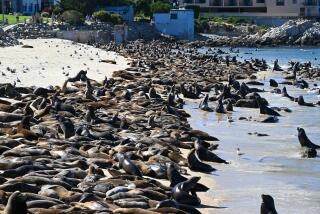Pigeons Seem to Be Everywhere as Sausalito Considers a Feeding Ban
- Share via
SAUSALITO, Calif. — Mark Flaherty has tried it all: $35,000 worth of screens, twirling metal devices on the roof. The general manager of the Inn Above the Tide even hired scuba divers -- twice -- to try to keep flocks of pigeons from roosting under the upscale waterfront hotel.
“We solved our problem here with a tremendous amount of expense,” Flaherty said. “They’ve migrated to the neighboring building.”
Hoteliers, restaurateurs, business owners and city officials alike in this tourist mecca by San Francisco Bay have had enough. The pigeons, they say, are out of control.
City officials are even considering an ordinance banning feeding of the pesky birds. In the meantime, they will ask visitors and residents to stop putting out seeds and bits of bread, among other attractions.
“At this point, I simply will try and evaluate if we can get people to voluntarily comply,” Sausalito City Manager Dana Whitson said.
Some say that might not be enough. Deborah Conners, general manager of the Water Street Grille, said an ordinance might be necessary.
Although she has strung wires along the restaurant’s window boxes and closed roosting spots in the eaves, she has been unable to get the pigeons to leave. And any time there’s a minor disturbance, the flock takes flight around the restaurant before settling on the roof again.
She’s forced to scrub down the patio and sterilize the outdoor tables every day. And now, after receiving a letter from the state Division of Occupational Safety and Health, she’s faced with buying protective clothing for workers who clean feathers from a roof overhang.
Sausalito’s city manager is intrigued by an idea she read about on the Internet to reduce the population: building alternative roosting spots away from downtown, then removing the eggs.
“We have enough problems on our hands without going to collect pigeon eggs,” Whitson said. “But they’re attractive little structures.”
Whitson already has ruled out several other ideas, such as the use of falconers to send out hawks to pick off the birds, and birth control medication in feed, which the city researched and found didn’t work very well.
Melanie Piazza, director of animal care at WildCare Terwilliger Nature Education and Wildlife Rehabilitation in San Rafael, said controlling the feeding of pigeons is the key. She said an artificial food supply causes a high birthrate that the environment can’t support.
And because pigeons, unlike songbirds, can breed all year, the population can grow out of control quickly.
The birds, of course, have their supporters. As the only center that rehabilitates them in the Bay Area, WildCare treats about 200 pigeons a year, most of them from San Francisco, Piazza said.
People feel so strongly about the birds that they’ll drive across the Golden Gate Bridge to Marin County if they find chicks that have fallen from their nests or birds that have gotten burned while dumpster-diving in grease behind restaurants, she said.
The city of San Francisco has banned the feeding of pigeons in most areas since the 1970s and has issued numerous citations over the years, said Carl Friedman, director of San Francisco Animal Care and Control.
But the city has set aside seven areas -- mostly parks -- where pigeon feeding is allowed.
He said efforts to control feeding and methods to make building roofs and ledges inhospitable seem to have worked, noting: “I think the problem has gotten better.”
Friedman said San Francisco has outlawed what it considers inhumane methods for reducing the pigeon population, saying, “You’re not allowed to poison, trap them or hurt them in any way.”
In Monterey County, officials have had an ordinance on the books banning the feeding of wildlife, including pigeons, since the late 1980s or early 1990s, but they prefer the gentler approach of handing out cards to people who feed the birds, explaining why it’s harmful, said Lisa Hoefler, director of operations for SPCA of Monterey County.
Volunteer groups that work at the beaches and the Monterey Bay Aquarium and animal-control officers distribute the cards, asking people to pass them on to others after reading them.
“I think it works fairly well,” Hoefler said. “It gives them a tool rather than telling somebody, ‘You’re doing the wrong thing.’ ”
More to Read
Sign up for Essential California
The most important California stories and recommendations in your inbox every morning.
You may occasionally receive promotional content from the Los Angeles Times.










